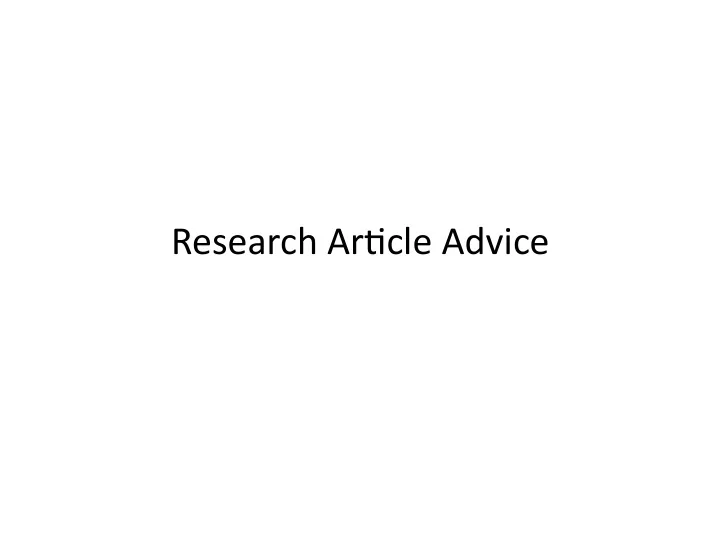

Research Ar*cle Advice
The Importance of Sub‐sec*ons • An effec*ve way to help readers follow the logic of your argument, improve “flow” • Definitely used in Methods, Results • Usually helpful in Discussion, too (underused!) • Rarely used in Introduc*on – but work from big picture to small
Results • Purpose: present data in a rela0vely unbiased way, but with some guiding framework • Focus on rela*vely certain conclusions here; more specula*ve interpreta*on belongs in the discussion sec*on. – Technical vs. scien*fic conclusions • Organize sub‐sec*ons by func*onal content, not by lab day. • Per sub‐sec*on, a wri*ng strategy – Overview sentence introducing that experiment (“in order to…”) – Walkthrough of relevant figure – Primary conclusion reached from that experiment – Intro/concluding sentences can also transi*on between data.
Methods vs. Results • Methods : “DNA was extracted from XL1‐Blue cells by a miniprep procedure. Cells from 1.5 mL of each liquid culture were spun down and resuspended…” • Results : “Amplified DNA was isolated in order to evaluate the success of the mutagenesis reac*on, and ul*mately produce mutant protein. Two individual colonies carrying X#Z DNA were grown in liquid culture, then lysed to obtain DNA. Both candidates, along with S101L DNA from a colleague, were tested by sequencing and restric*on digest…”
Discussion • Purpose: interpret and contextualize the data • Reiterate major findings first! Then, do some/all of: – Connect your findings to other research, published or peer – Describe any ambigui*es and sources of error, then suggest future experiments to resolve uncertain*es – Explain where the work may lead, and suggest specific experiments for extending your findings – Describe any conceptual or technical limita*ons – Explain the significance of your findings to basic science and to engineering applica*ons • Should have a clear organiza8on and narra8ve flow • Should interpret data holis8cally
Results vs. Discussion • Results : “We observed dark bands at 50 kD – the predicted size of inverse pericam. However, the lysates from induced D131G cells appeared to have a slightly retarded mobility with respect to those from wild‐type and induced S101L cells. ” • Discussion : “To test our hypothesis that inverse pericam was produced in induced cells, lysates were run on a SDS‐PAGE and results indicated that the mutant proteins were produced (Fig. 4). However, we observed that the D131G mutant inverse pericam protein had a slightly retarded mobility. Since we did not observe any addi*onal muta*ons in the sequencing results, we do not believe that this result indicates an erroneous D131G protein. Instead, the protein product may not have been purified completely, and a few contaminants may have been present.”
More Discussion Examples • These differences in binding affinity… are not sta*s*cally significant. Further trials are required to confirm our results… and should include tes*ng more calcium concentra*ons. • Although both of our values were slightly greater than Nagai et al’s, we analyzed 13 colleagues’ data and observed that four others have reported similar data. • Calcium binding affinity was decreased for the D131G mutant. This result was expected, since subs*tu*ng glycine for the nega*vely‐charged aspartate should reduce ionic interac*ons with the posi*vely‐charged calcium ion (Fig. 1B). Binding affinity did not change dras*cally, perhaps because there are several other aspartates in the fourth binding loop that could compensate for the loss at residue 131.
Other sec*ons, briefly • Abstract : A micro‐report, from mo*va*on to results • Introduc4on : Mo*vate and contextualize the work – Not just a laundry list of background facts • Methods : Allow someone to repeat your work – Develop your intui*on for what is essen*al vs. extraneous • Cita4ons : Support your claims – Generally used in introduc*on and discussion – Should be relevant and thorough • Figures + Tables
Contextual Material • Introduc*on and Discussion are like bookends • Discussion should “close the loop” – Were research goals proposed in the introduc*on met? – Revisit mo*va*on and significance of the work. – Describe progress and future vision in terms of scien*fic knowledge or engineering applica*ons enabled. – Might repeat some of the literature cited in the introduc*on, as well as some addi*onal literature.
Order of assembly • Start with Figures and Results – you can’t write context if you don’t know what it’s context for • Then work on Discussion and Introduc*on (with References – cyclic process to some extent) • Finally, write the Abstract
Recommend
More recommend